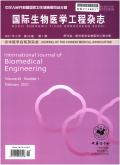Brain tissue segmentation method based on maximum between-cluster variance optimized by the difference search algorithm
引用次数: 0
Abstract
Objective To study a maximum between-cluster variance based on differential search algorithm, and to select the multi-threshold for effectively segmentation of brain magnetic resonance images. Methods The brain extraction tool(BET) algorithm was used to remove the non-brain tissue part of the original magnetic resonance image. The best-fit with coalescing(BFC) algorithm was used to remove the intensity non-uniformity. The differential search algorithm was used to optimize the maximum between-cluster variance of the image to find the optimal threshold for multi-threshold segmentation of the magnetic resonance image. The method was validated using simulated magnetic resonance(MR) brain image data provided by BrainWeb. Results For MR images with different noise levels and intensity inhomogeneities, the proposed method was better than FSL, SPM and Brainsuite methods. Conclusions The maximum between-cluster variance based on differential search algorithm has better segmentation accuracy and robustness, especially for cerebrospinal fluid. Key words: Magnetic resonance imaging; Differential search; Image segmentation; Multi threshold; OTSU差分搜索算法优化的基于最大聚类方差的脑组织分割方法
目的研究基于差分搜索的最大聚类方差算法,选择多阈值对脑磁共振图像进行有效分割。方法采用脑提取工具(brain extraction tool, BET)算法去除原始磁共振图像中的非脑组织部分。采用最佳拟合合并(best fit with coalescing, BFC)算法去除图像的强度不均匀性。采用差分搜索算法对图像的最大聚类间方差进行优化,找到对磁共振图像进行多阈值分割的最佳阈值。使用BrainWeb提供的模拟磁共振(MR)脑图像数据对该方法进行了验证。结果对于不同噪声水平和强度不均匀性的MR图像,该方法优于FSL、SPM和Brainsuite方法。结论基于最大聚类间方差的差分搜索算法具有较好的分割精度和鲁棒性,尤其对脑脊液具有较好的分割效果。关键词:磁共振成像;微分搜索;图像分割;多阈值;大津
本文章由计算机程序翻译,如有差异,请以英文原文为准。
求助全文
约1分钟内获得全文
求助全文

 求助内容:
求助内容: 应助结果提醒方式:
应助结果提醒方式:


